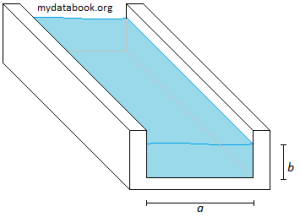Reynold’s Number
The Reynold’s number is a dimensionless number that characterises the flow of a fluid and is represented by:
(1) ![]()
Where Re = Reynold’s number, ![]() = density, u = fluid velocity,
= density, u = fluid velocity, ![]() = characteristic length or hydraulic diameter,
= characteristic length or hydraulic diameter, ![]() = dynamic viscosity. It can be alternatively written in terms of the kinematic visocity:
= dynamic viscosity. It can be alternatively written in terms of the kinematic visocity:
(2) ![]()
Where ![]() = kinematic visocity and is equivalent to
= kinematic visocity and is equivalent to ![]() .
.
The Reynold’s Number characterises the flow as laminar when Re < 2000, as transient when 2000 < Re < 4000 and as turbulent when Re > 4000.
Characteristic Length / Hydraulic Diameter
The characteristic length, also known as the hydraulic diameter, is the ratio of cross-sectional area to the ‘wetted’ perimeter of the tube or channel the flow is moving through. It is defined as:
(3) ![]()
Where A = cross-sectional area and P = perimeter of the channel or tube in contact with the fluid.
For example, the characteristic length for a fully filled tube with internal diameter, D, is:
(4) ![]()
For a fully filled square channel with side length, L, the characteristic length is:
(5) ![]()
A partially filled rectangular open channel with width, a, and height, b, is shown below:

Here, only 3 surfaces are in contact with the fluid and are ‘wetted’. The ‘wetted’ perimeter is therefore only (a + 2b). As such the the characteristic length is:
(6) ![]()
Reynold’s Number Calculator from Dynamic Viscosity
Reynold’s Number Calculator from Kinematic Viscosity